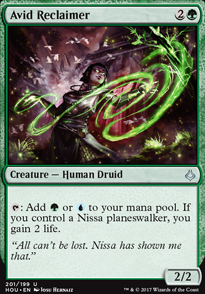-
Liliana, Death Wielder
: This is actually a very good planeswalker in this deck...she does everything we need her to do here- produce counters, destroys creatures & returns our combo pieces to us. This may not be a bad idea to play if you are running creature-heavy.
-
Ob Nixilis Reignited: Here is another great walker for us. Gives us some card advantage, helps get rid of creatures, and will help ping away your opponents life total if you can ultimate him.
-
Consuming Fervor
: A great card choice along side
Channeler Initiate. After being pumped you can get some damage out of him if need be, and this combo will produce an additional mana, every turn for the rest of the game if it remains on the board. Basically look at this as another way to produce tokens if
Hapatra, Vizier of Poison or scarab nest is in play.
-
Splendid Agony
: Dumb down your opponents board with this card. This works great in conjunction with
Blazing Volley
if timed right...Don't forget- more tokens!
-
Hapatra's Mark: If you end up having to drop some poison counters on an undesirable creature, which will happen, this will fix that, as well as protect the creature for a turn. Maybe not a bad sideboard option.
-
Heroic Intervention: This is self explanatory...A board wipe in the late game means game over in most cases while playing a deck like this. I would heavily consider this as a sideboard option, considering we have are not going to be playing any counterspells...I mean you can get brave and run
Glorious End
. It can work in your favor here.
-
Blazing Volley
: A lot of people say this card is unplayable...But- under the right circumstances, this can be one of the best cards in the deck. I wouldn't have more than 2 spread across your main & side board.
-
Burn from Within: Indestructibility isn't an issue we face most of the time here, dishing out poison counters on everyone's turn, but this certainly is a great card is the combo's aren't going off in time. Having
Channeler Initiate or two on the board, we can do as much damage as we need usually (Early-Mid Game) to counter any early threats.
-
Grasp of Darkness: Played for obvious reasons...although is doesn't give us anything but removal- being able to have some control over our opponent is a must.
-
Magma Spray: With
Soul-Scar Mage on the battlefield, this not only can take out creatures early, but can give us more tokens.
-
Claim//Fame: If you have trouble keeping Haptra, Vizier of Poison on the battlefield, this is the card you want to draw in that case. You can bring her back from the graveyard to the battlefield for one mana. Now the other half of the card isn't terrible either.
-
Cut / Ribbons: Double
Shock? Alright. The aftermath is alright as well!
-
Galvanic Bombardment: Maybe not as great of a card as
Magma Spray, in terms of having the ability to send a creature to exile...but can potentially be more powerful. Along with
Soul-Scar Mage, the more of these in your graveyard means more -1/-1 counters, which in turn means...you guessed it, more tokens.

